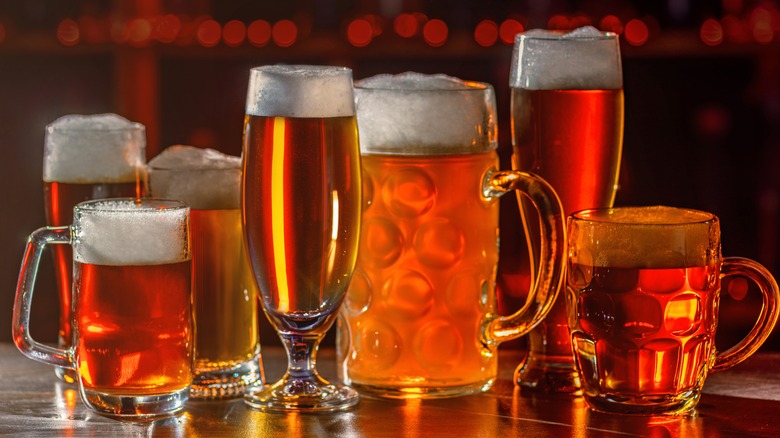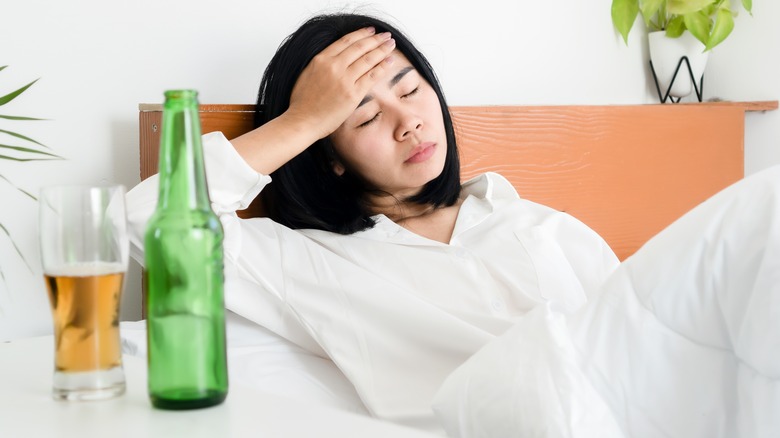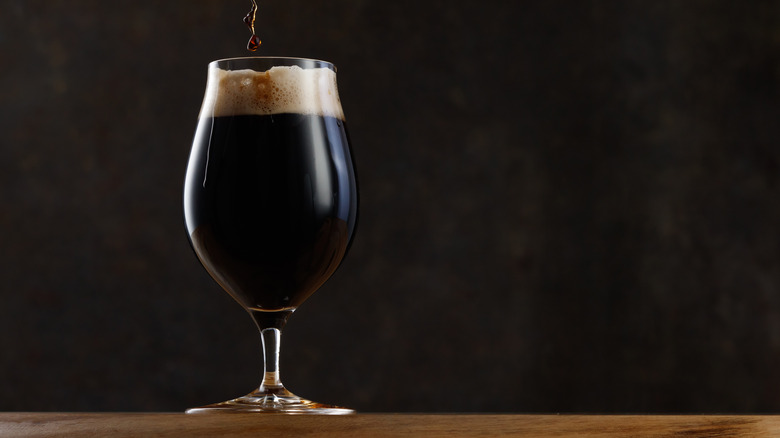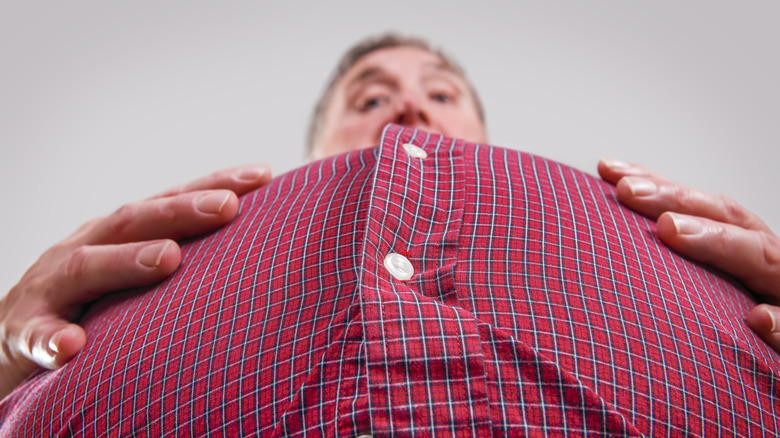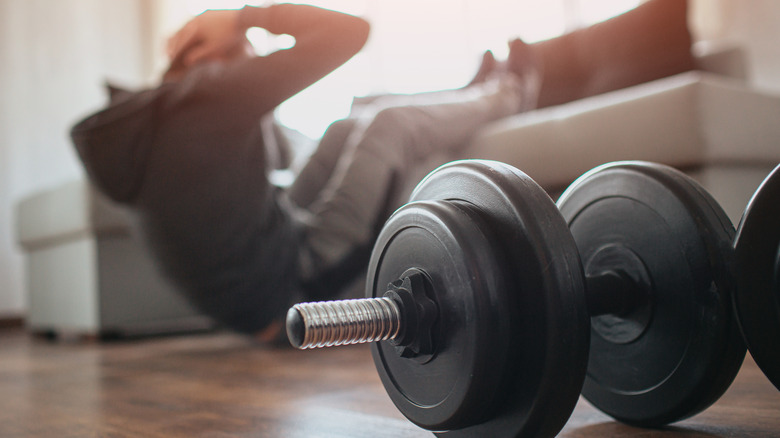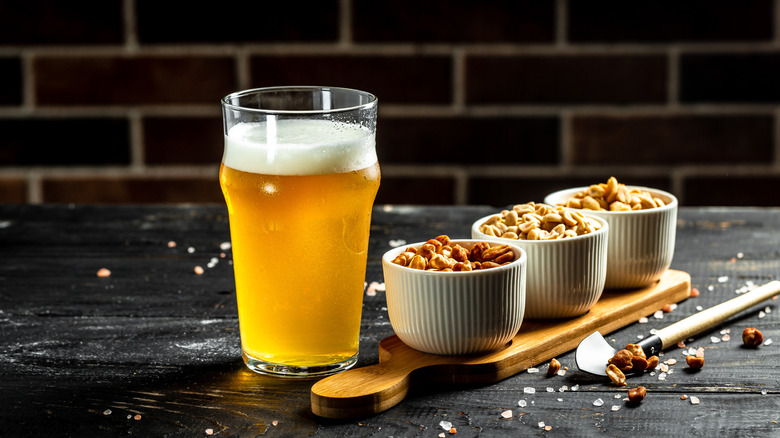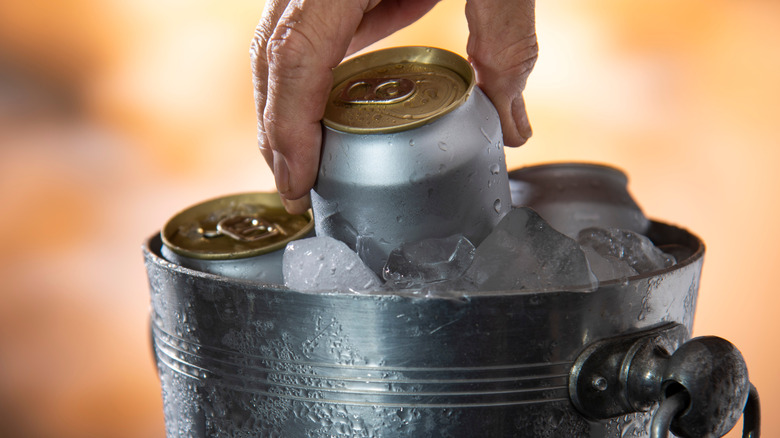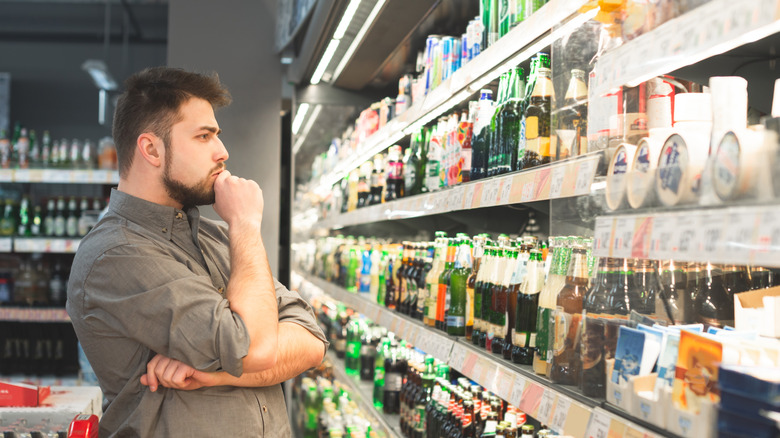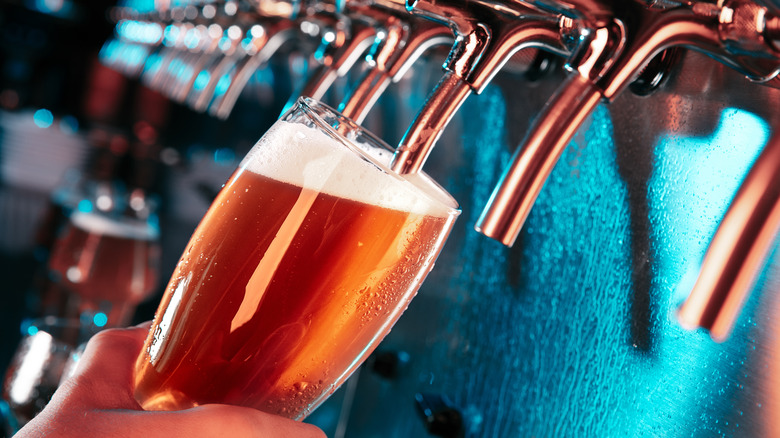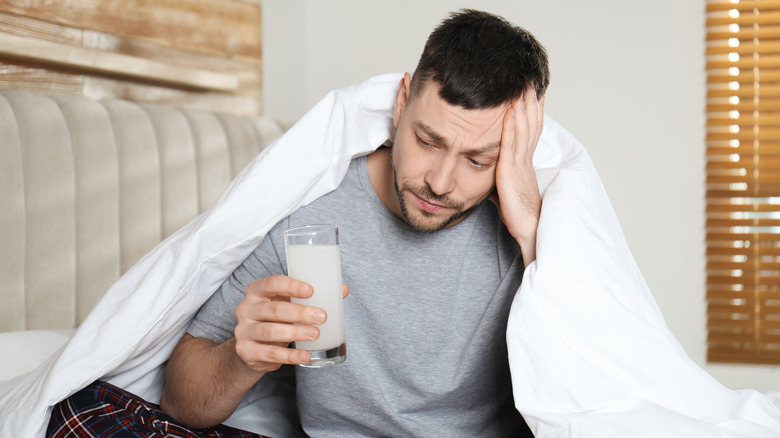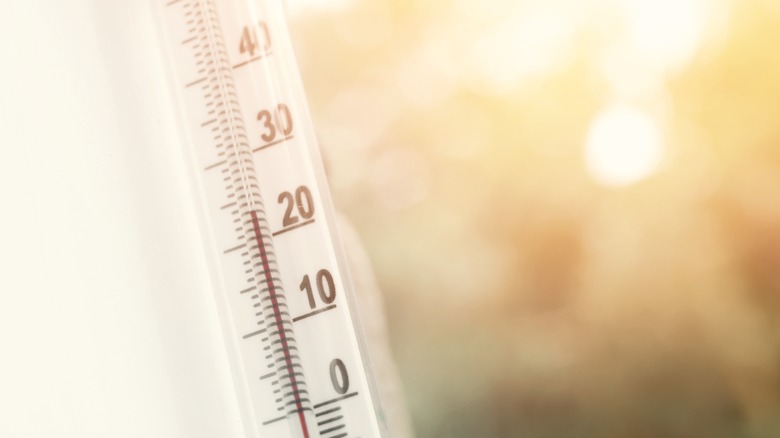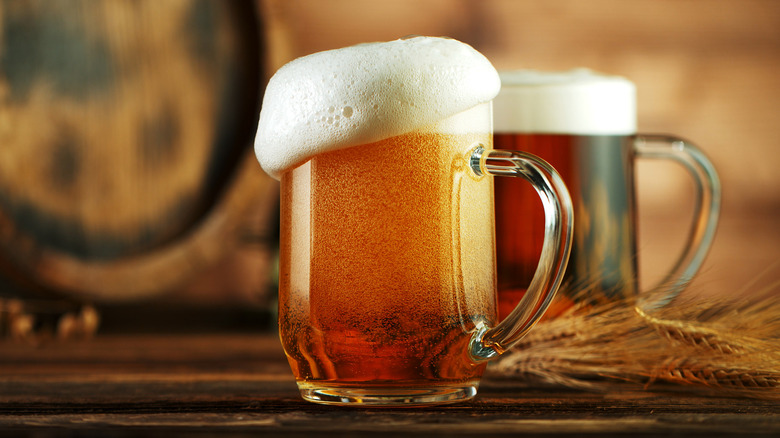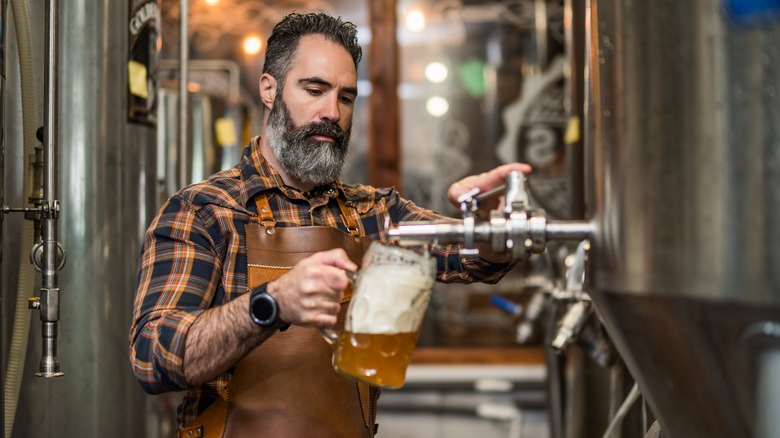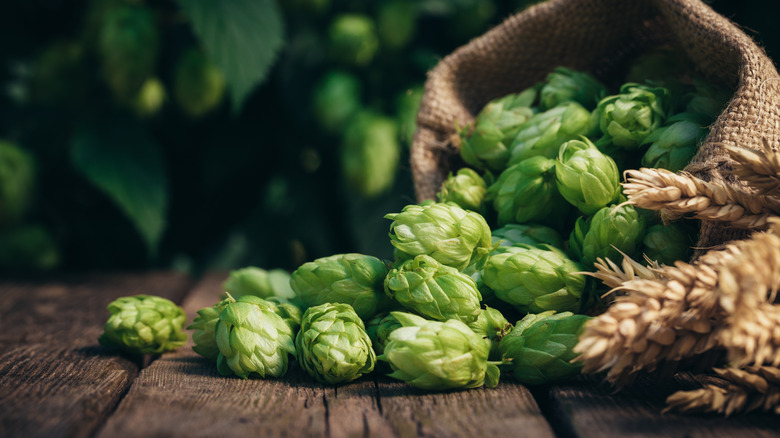14 Common Beer Myths You Should Forget
We may receive a commission on purchases made from links.
Brewski. Suds. Wallop. Whatever you call it, beer is a favorite beverage across the world and has been for centuries. It's so beloved that we write songs about it, host festivals all about it, and create slang terms about it — beer goggles, anyone?
Aside from being an iconic beverage, beer itself is also a hot conversation topic among beer lovers everywhere. While many can agree that beer, in general, is one of humankind's greatest gifts, there are other things that aren't so easily agreed upon. Which country has the best beer? Which kind of brew is superior? What is the best brewery? Ask a handful of strangers on the street and you'll have varying answers and may even start a debate while you're at it.
Personal preferences may be contested, but what's not up for debate are the facts when it comes to beer. According to the Beer Institute, temperature does matter, there is a correct way to pour beer, and many of the things you think you know about beer are actually myths.
Sorry to burst your bubble, but here are some common beer beliefs that are more tall-tale than truth.
1. Myth: Drinking beer before liquor will make you sicker
Most people know the rhyme: Beer before liquor, never been sicker. Liquor before beer, you're in the clear.
Like many wives' tales, this saying is passed down as an undoubted truth from college student to college student, from parents to their adult children, etc. However, also like many wives' tales, this particular rule of thumb isn't actually grounded in scientific truth.
As it turns out, the order you drink your libations in doesn't matter when it comes to feelings of sickness or a hangover. What does matter, however, is the amount of alcohol consumed and the time frame it was consumed in (via Healthline).
So, yes, sipping beer all night and then doing a bunch of shots before going home might make you feel sicker, but only because you drank a greater amount in a shorter time period. Liquour has a much higher alcohol volume in a smaller amount than beer. Drinking liquor first might lower your inhibitions faster, which makes you think having one beer, and then another, and then another is a good idea. Hello, hangover.
2. Myth: Darker beers are healthier
The assumption with this myth is that because darker beers, like darker wines, often have more antioxidants (a.k.a. flavonoids) they must be healthier than their lighter counterparts (via Biomolecules). After all, antioxidants fight free radicals, right? That's good for your health.
Yes, but not so fast. Having a higher flavonoid content is unfortunately not a reliable metric of health on its own. There are many factors that contribute to the overall healthiness of something and rarely is something perfectly healthy. Celery is generally good for you, but can quickly lead to gut issues in excess (via Livestrong). Water is crucial for our bodies, but drink too much of it at once and it can make you very sick (via Medical News Today).
While darker beers may have more antioxidants, it comes at a price. Dark beers also often have higher amounts of the chemicals that cause hangovers (via Mayo Clinic). So while your pint of Guinness might be superior in some ways, it's not all sunshine and rainbows if the next morning has anything to say about it. You win some, you lose some.
3. Myth: Darker beers are higher in alcohol content
Many people think that because darker beers look thicker, have a fuller taste, are higher in carbs, and are higher in calories that it must mean dark beers always have a higher alcohol content (via Craft Beer Club). While dark beers are robust, yes, they aren't always as potent as you'd think.
Color has no determining factor on alcohol content. In fact, some darker beers have lower alcohol levels than some lighter ones. There are even non-alcoholic dark beers. As Craft Beer Club explains, what determines alcohol by volume (ABV) is not the color, but the sugar content and total calories.
The higher the ABV, the more maltose (sugar) is required, and the more calories you'll find. This applies to any and all beers, dark or light. So don't judge a beer by it's color. The only true way to know the alcohol content is to look at the ABV.
4. Myth: Drinking too much beer leads to a beer belly
The beer belly is a popular enough concept that they've become inspiration for fanny packs (via Amazon) and the butt of a few dad jokes. However, the term itself is a little deceiving. It creates an assumption that someone's stomach size is directly affected by how much beer they consume, but there's a little more to it than just that (via Time).
While drinking beer can make you bloated and thus increase the size of your stomach temporarily, it is not solely responsible for increasing the amount of stomach fat on a person's body. Sure, it can be a contributing factor, but it's not the only source. Furthermore, beer and fat are often thought of synonymously, but beer doesn't contain fat at all. That's right, beer is fat-free (via Healthline).
What actually causes a "beer belly" is eating an excess in calories consistently over time, combined with an inactive lifestyle. When you regularly consume more calories than you burn in a day, you gain weight — beer or no beer.
5. Myth: Beer can help you recover after a workout
When initial research came out that suggested beer could potentially rehydrate athletes, many took it and ran, no questions asked. The idea was that, like your typical recovery drink, beer had sugar-based carbs, nutrients, and some electrolytes to help your body recharge (via International Journal of Sport Nutrition and Exercise Metabolism). Having a brew after busting your butt in the gym without stalling your progress? Sounds too good to be true — and it kind of is.
Unfortunately, beer is not some magical recovery elixir. Subsequent studies have shown minimal rehydration benefits from drinking beer after a workout. In fact, the same post-workout rehydration can be achieved with your standard sports drink (via PLOS ONE).
Furthermore, drinking beer after a workout has more negative side effects than drinking a sports drink to refuel. Alcohol actually slows muscle growth and repair in addition to slowing down your metabolism (via Men's Journal). It goes without saying, that's not ideal when it comes to getting shredded. Of course, you're welcome to treat yourself to a hard-earned brew, but maybe rethink relying on it to help you reach your fitness goals.
6. Myth: Lighter beers are the healthier choice
The common belief is that because light beers are often lower in calories, they're automatically healthier. In a perfect world, that could have some truth to it, but the world we live in is rarely perfect. The lower the calories, the more people tend to consume overall. This is often where beer drinkers stray.
The perception is that in exchange for fewer calories, they can take in more volume. The reality is that because many light beers are lower in calories, people tend to think they can drink more light beer for less calories than they would dark beer. As a result, they actually end up consuming more total calories than they intended without realizing it (via Greatist). The numbers add up fast.
It's also worth noting that calorie counts in light beers vary among brands and, like antioxidant levels, calories alone are not an accurate marker of how healthy something is. So take those light beer ads with a grain of salt and take a look at the actual nutrition label.
7. Myth: Beer is best served cold
Cool. Crisp. Refreshing. Advertising has led us to believe that a cold, frosted mug is best for all beer. While untrue, the sentiment makes sense. We think the same for water and other beverages. Yet, the best temperature to serve beer at depends on the type of beer being served (via American Homebrewers Association).
Surprisingly, there's a lot of interesting science behind beer, from the chemicals that play into flavor and texture to the physics of a good pour. The American Homebrewers Association explains that while a cold beer might sound refreshing, it can actually dampen the experience you have with that beer. Too cold a glass can numb your taste buds and thus dull the flavor. Serve it too warm, though, and it can go flat.
Your best bet? Look up the serving guidelines for your favorite type of beer. Of course, it also comes down to personal preference and you may be someone whose palate disagrees with what's suggested. To each their own.
8. Myth: Bottled beer is better than canned
Many beer aficionados will tell you that bottled beer tastes better because it lacks the unpleasant metallic tang found in canned beers. Most likely, this metallic taste is a placebo of sorts.
Science says beer is actually better suited for cans because they're better able to keep out light and air, which are two evils that cause beer to go bad (via Thrillist). The airtight seal of a can is more effective at keeping the taste fresh since it lacks the headspace found in bottles. The good news for bottles is that amber glass blocks out most of the light that skunk your beer, but the same cannot be said for green, blue, and clear bottles. So unless you're exclusively drinking from amber bottles, cans come out on top.
As a bonus, Thrillist explains that cans are also more environmentally friendly than bottles because cans weigh less and can be shipped in larger batches, which lowers the amount of shipping fuel used.
9. Myth: Draft is always better than bottle
Just as there are die-hard bottle-is-best believers, there are those that will die on the "draft is superior" hill. The thought here is that draft beer is the freshest you can get. That's true to a degree, but there are some stipulations.
As Bon Appetit explains, if your bar of choice maintains their tap lines, regularly cycles out their draft offerings, or tends to be a hotspot for patrons, then yes, you're probably going to get a pretty fresh pull. However, if a bar doesn't have well maintained tap lines, it can cause bacteria to build up, leading to a stale or acidic flavor (via Brewers Association). Typically, drafts are meant to move faster in bar sales than bottles and cans so it's usually the freshest of the three, but that's not always the case. If the bar you're at is one that sees less activity, then there's a higher chance the draft you order might be old news.
Worried about getting something stale? Ask the bartender what's fresh on tap and if all else fails, settle for a can or bottle.
10. Myth: Draft beer gives you a hangover
Opposite to a "draft is better" mindset, some may insist that draft beer gives you more of a hangover than canned or bottled beer. Some people may not have concrete reasoning for this belief and just accept it as fact. Others may try to claim that unwelcome bacteria in tap lines can lead to unpleasant physical symptoms. At a glance, it's one of those things you hear and think, "Sure, sounds about right."
Yet, it is just another myth compounded on top of another myth in a big mythical sandwich.
Bottled, canned, draft — there's not one form that will give you more of a hangover than another, and draft beer hangovers aren't caused by sinister bacteria lurking in tap lines, waiting to ruin your day (via Click2Houston). The reason people think draft beer leaves you more prone to hangovers is because draft beers are usually served in a higher volume — compare the average 16 ounce glasses to 12 ounce bottles and cans — increasing overall consumption and thus increasing risk of a hangover (via USA Beer Ratings). It's as simple as that.
11. Myth: Higher temperatures skunk your beer
If you're less versed in beer culture, you might be wondering what on Earth "skunking" is. Simply put, skunking is a chemical reaction that happens when the hops in beer are exposed to light. As a result it causes the flavor of your brew to go off (via Allagash Brewing Company).
This particular myth is fueled by the assumption that light and temperature are interchangeable. Scientifically speaking, they are not the same thing and they have very different effects. Skunking occurs specifically because of light interacting with particular molecules in your beer and has nothing to do with temperature at all. While warmer temperatures can make some beers go flat or speed up oxidation, it won't skunk them (via Allagash Brewing Company).
It just so happens that when there's light, there's often a corresponding temperature difference, so it's easy to see where the misconception comes from. So next time you're enjoying a brew on a warm day, don't worry so much about keeping it cold and instead be mindful of direct light sources (usually the sun).
12. Myth: A foamy head equals less beer
Like the disappearing act we see with cotton candy, there's a misconception floating around that more foam equals less beer. Some consider a foamy head a major rip off, since foam appears to have less volume than the liquid beneath and seems to melt away. After all, you want the most bang for your buck, right? The foam on top of your draft pull is called the "head" and it's a perfectly natural part of the beer experience (via The Kitchn).
However, all is not what it seems. A foamy head on beer actually helps lock in flavors through some complicated chemistry you can look up if you're into that kind of thing. In layman's terms, though, a foamy head helps soften the effect of the flavor on your palate, which in most cases makes the beer taste better. Plus the physical feel of the foam itself has a big impact on how you perceive the beer (via Craftbeer.com).
It's also important to keep in mind how connected our senses of smell and taste really are.The foamy head brings the smell of the beer to the topr, opening up your taste buds to the entirety of the flavor.
13. Myth: All craft beers should be aged for better taste
Like fine wine, things get better with time, right? Not always. Many people assume that craft beer is best when it's aged. However, that's not the case for all craft beers. It's best to think of aging like this: it doesn't make the beer better or worse, it just changes the flavor. Some types of beer work better with certain flavors (via Los Angeles Times).
For instance, aging some high-alcohol beers definitely improves their flavor profile and mellows things out for a harmonious taste. But as the Los Angeles Times explains, other craft brews, particularly hoppy ones, are best when they're fresh since oxidation in the aging process can actually dull their flavor.
These are generalizations and, when it comes down to it, what tastes better is subjective. If you're looking into brewing and aging your own beer, do a bit of research on what's recommended for the type you're brewing and then adjust for your personal preference.
14. Myth: More hops equals more bitterness
This one is a little tricky. It's sort of true, but not in totality. While it's true that bitterness in beer is determined by the alpha acid content of the hops used, the quantity of hops doesn't automatically mean a beer is more bitter. As Craft Beer & Brewing explains, many breweries use a technique called "hop bursting." This means they add large amounts of hops at the end of the boil, resulting in a beer with strong hop flavor and aroma, but significantly less bitterness than if those hops were added at the beginning.
Additionally, bitterness itself is actually not a flavor — it's a sensation and different people perceive it to different degrees (via Scientific American). Generally, though, the leftover sweetness in a beer directly affects how bitter most people perceive a brew to be.
So bitterness in beer is much more complicated than just the amount of hops used. It's basically a science.
